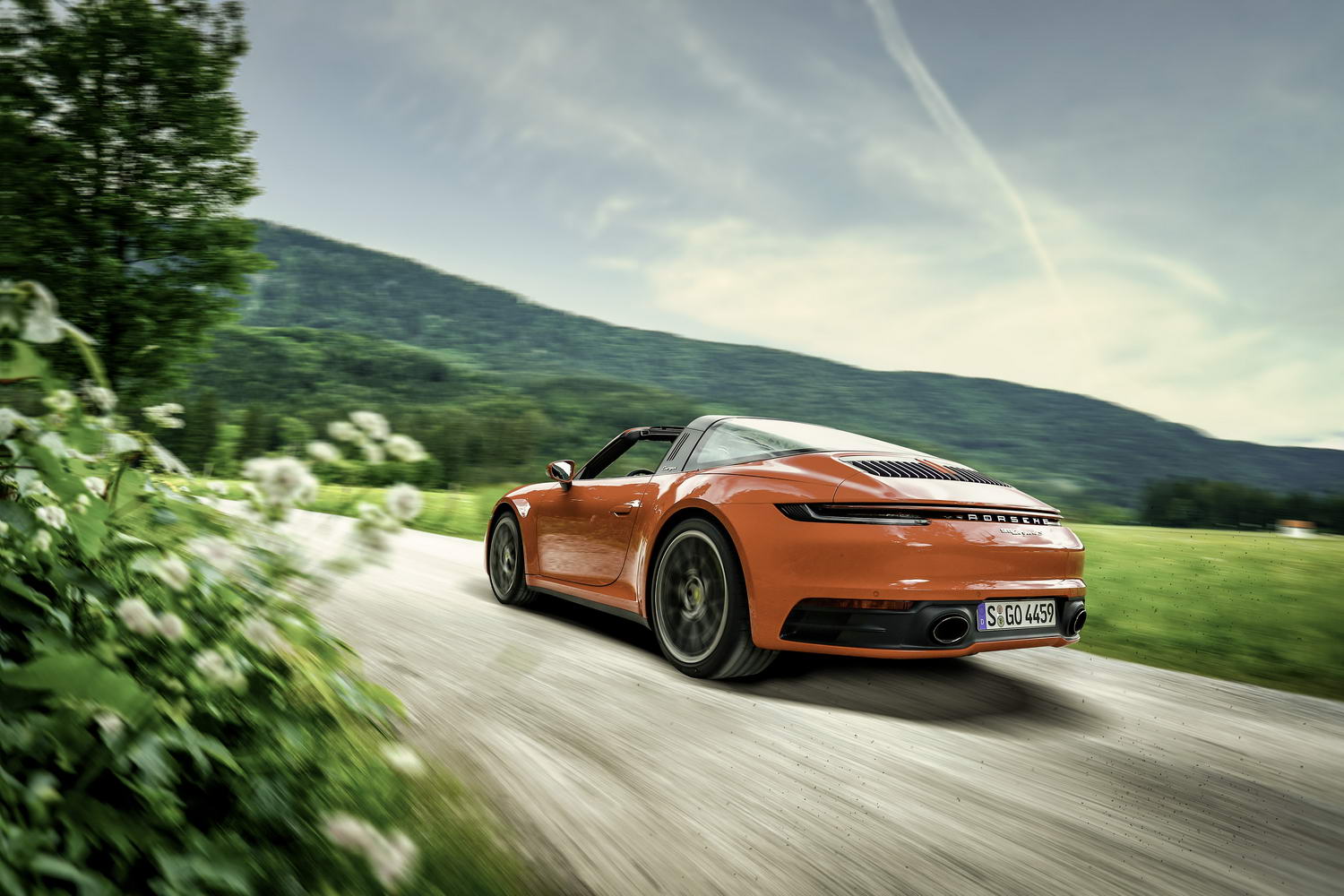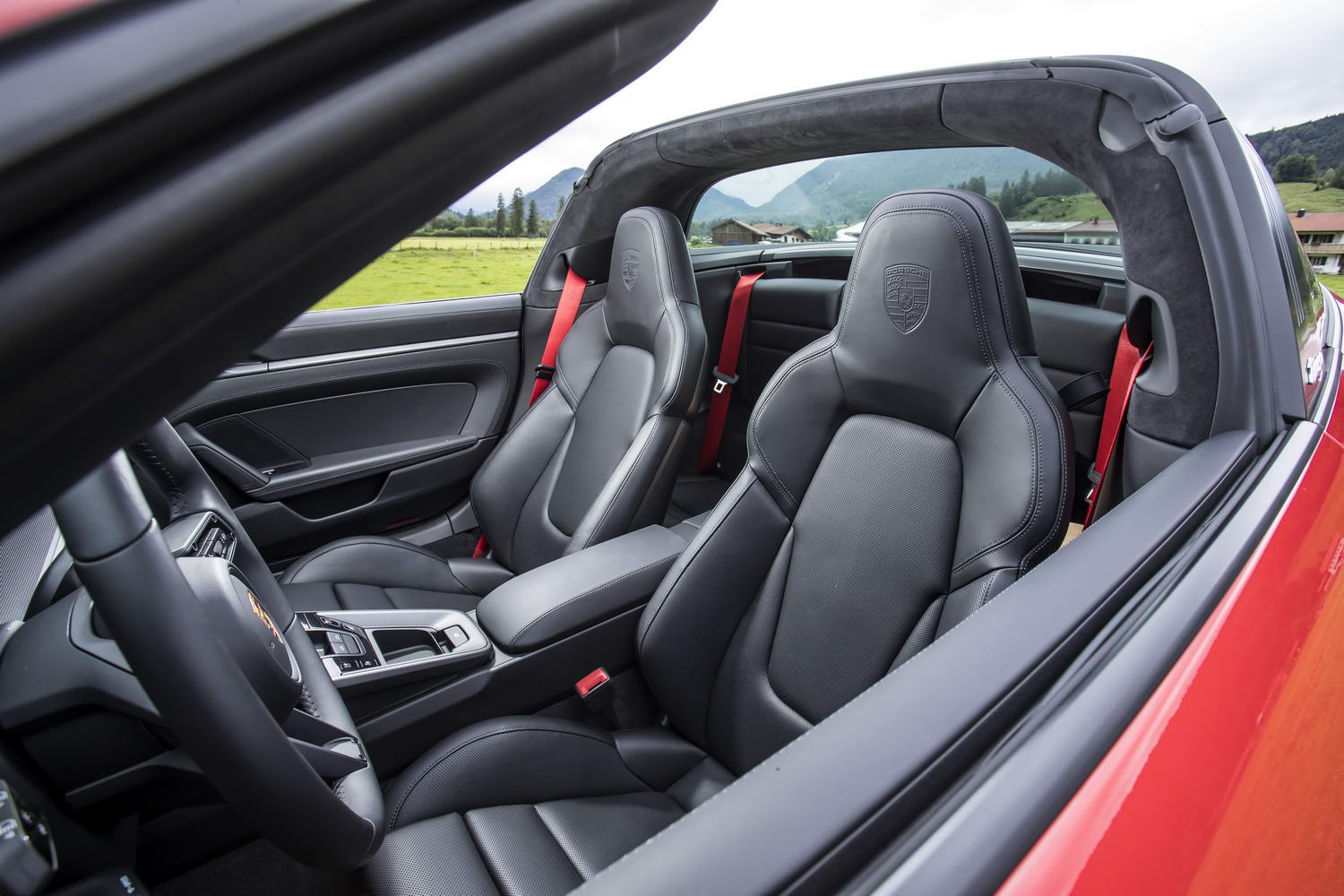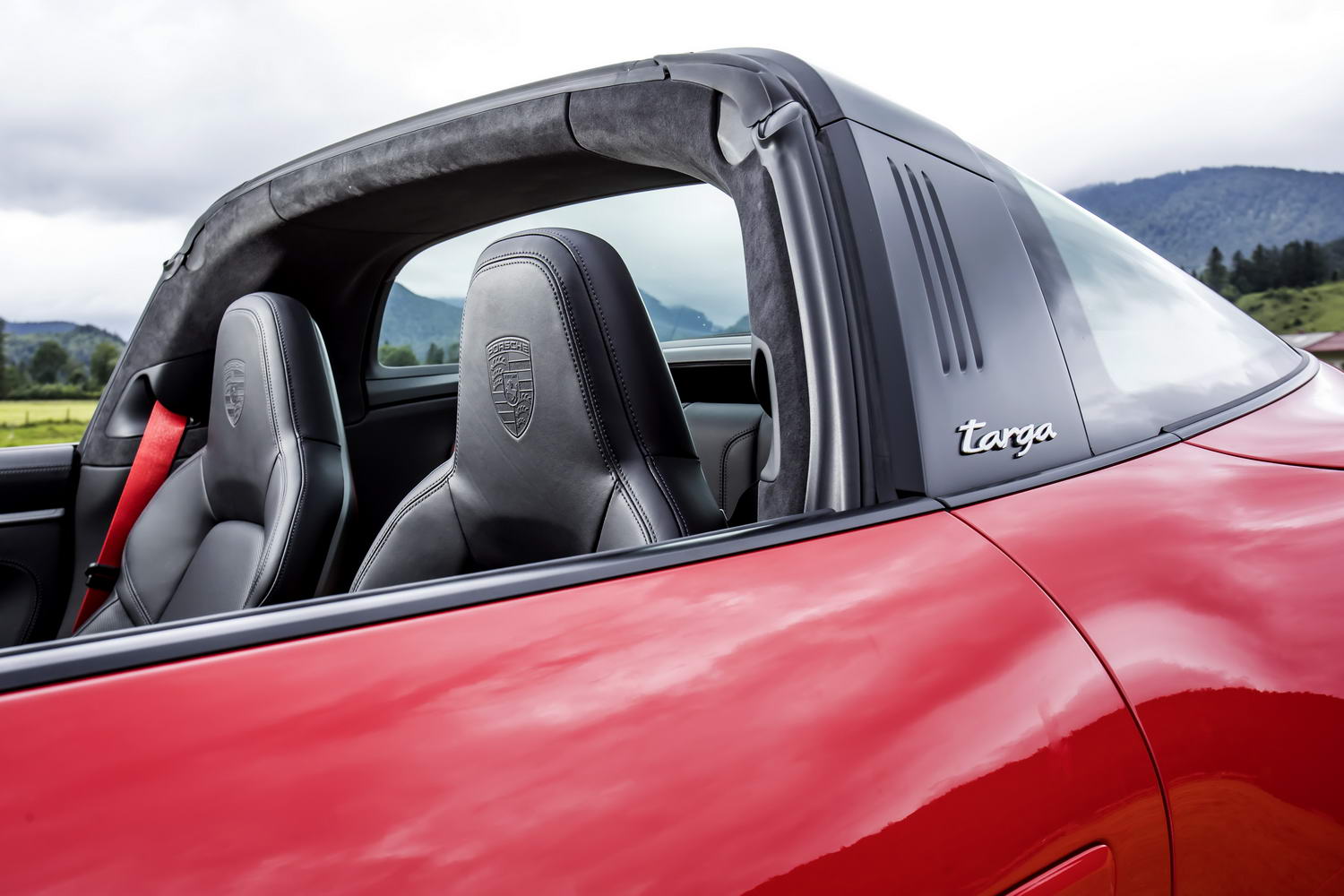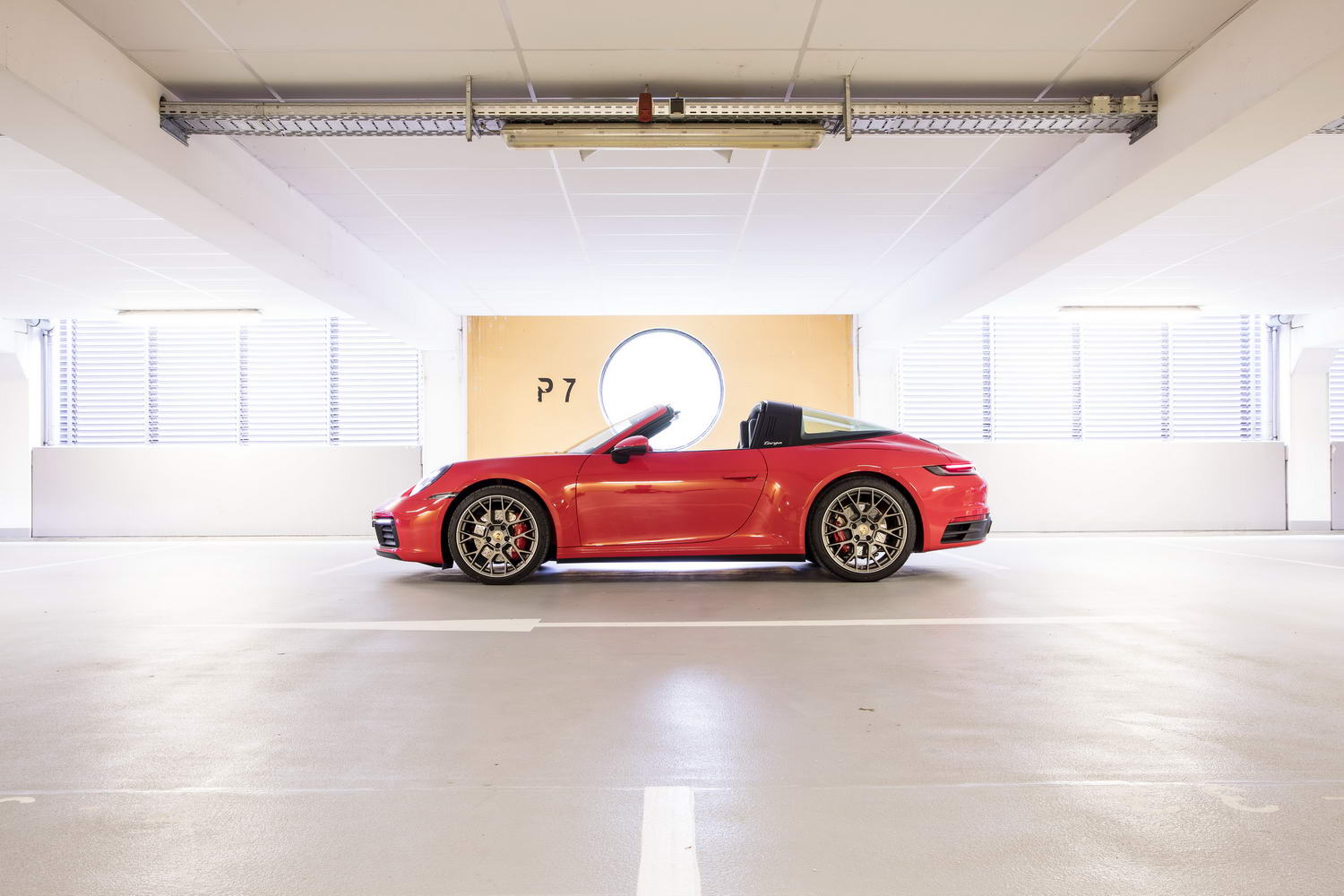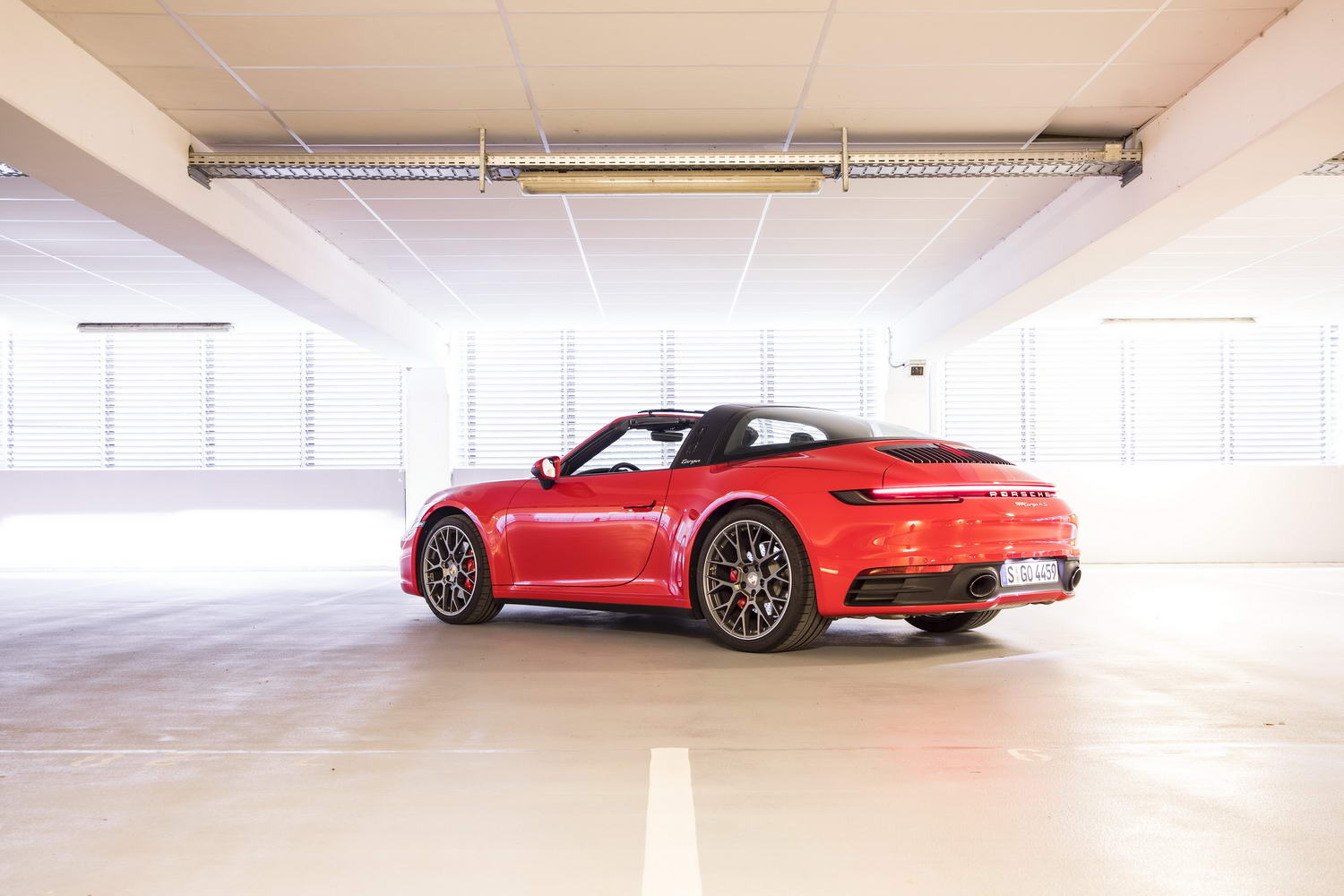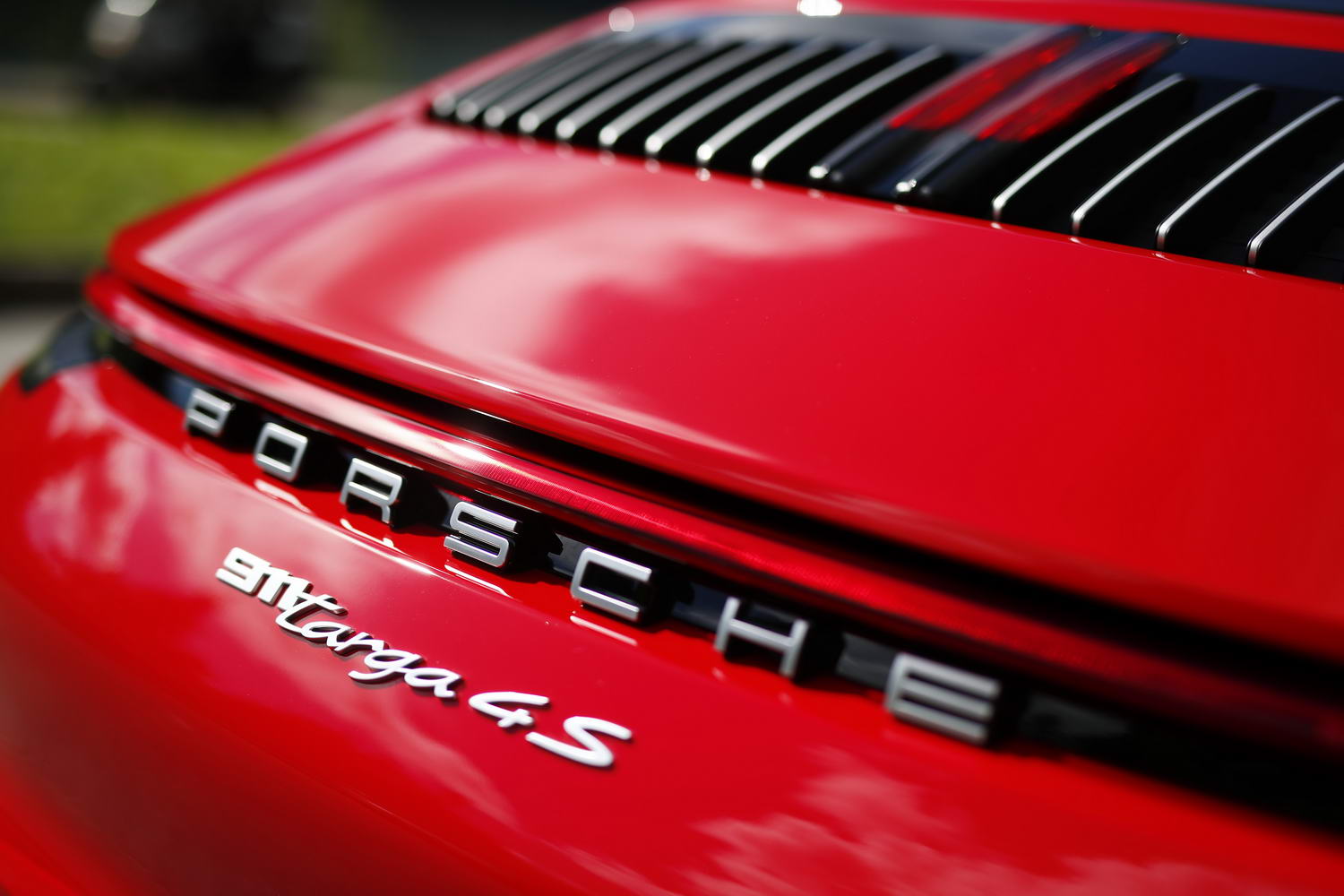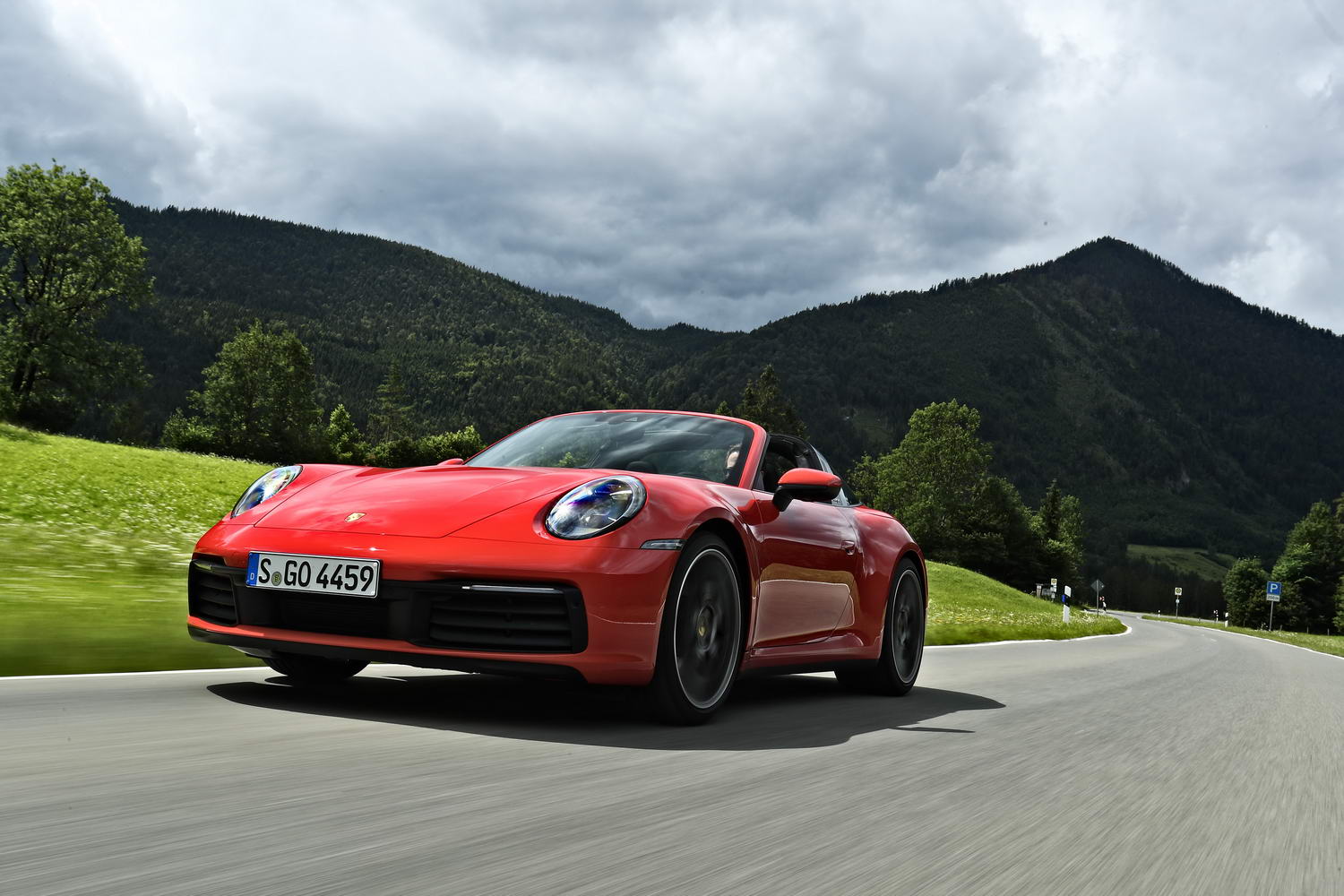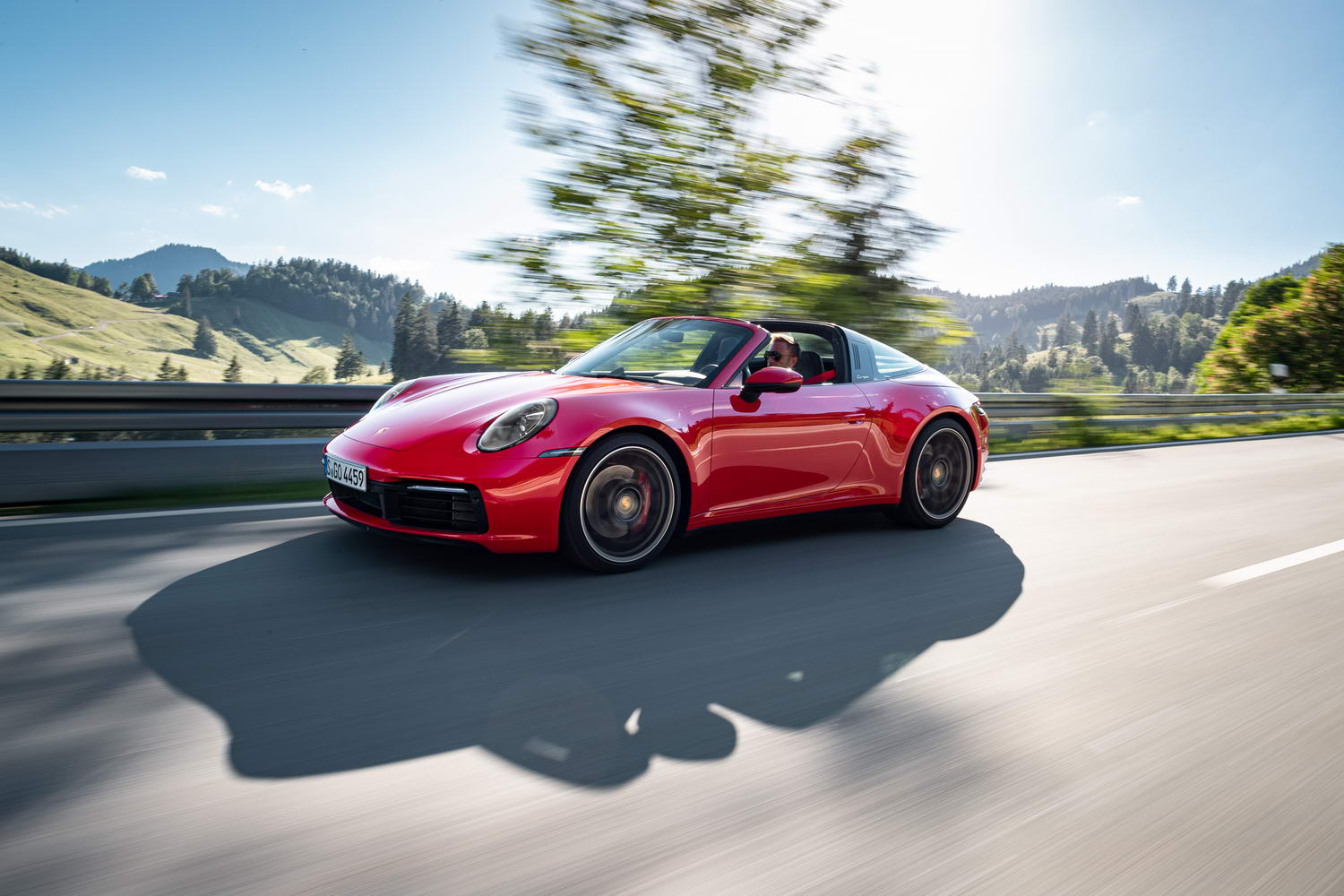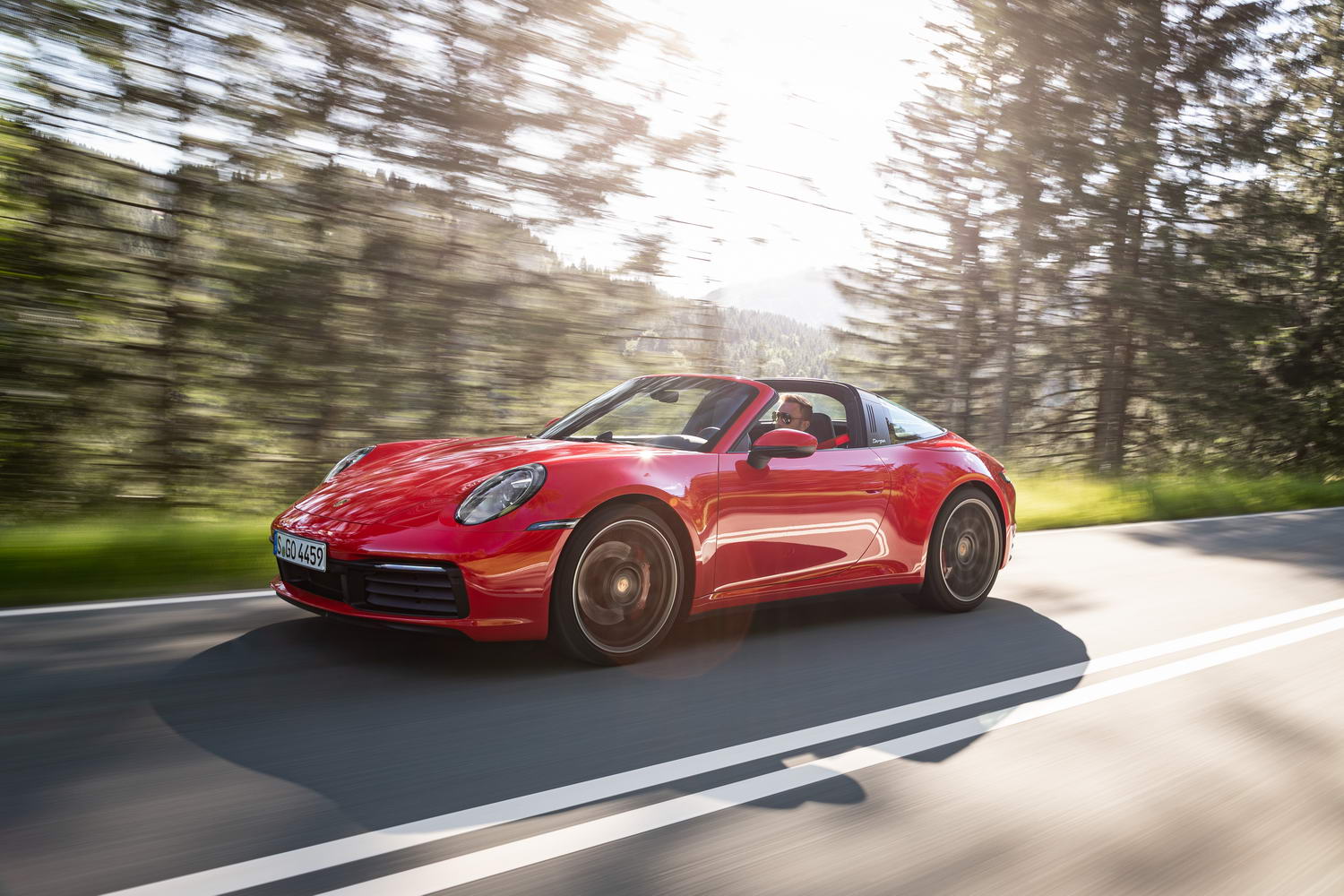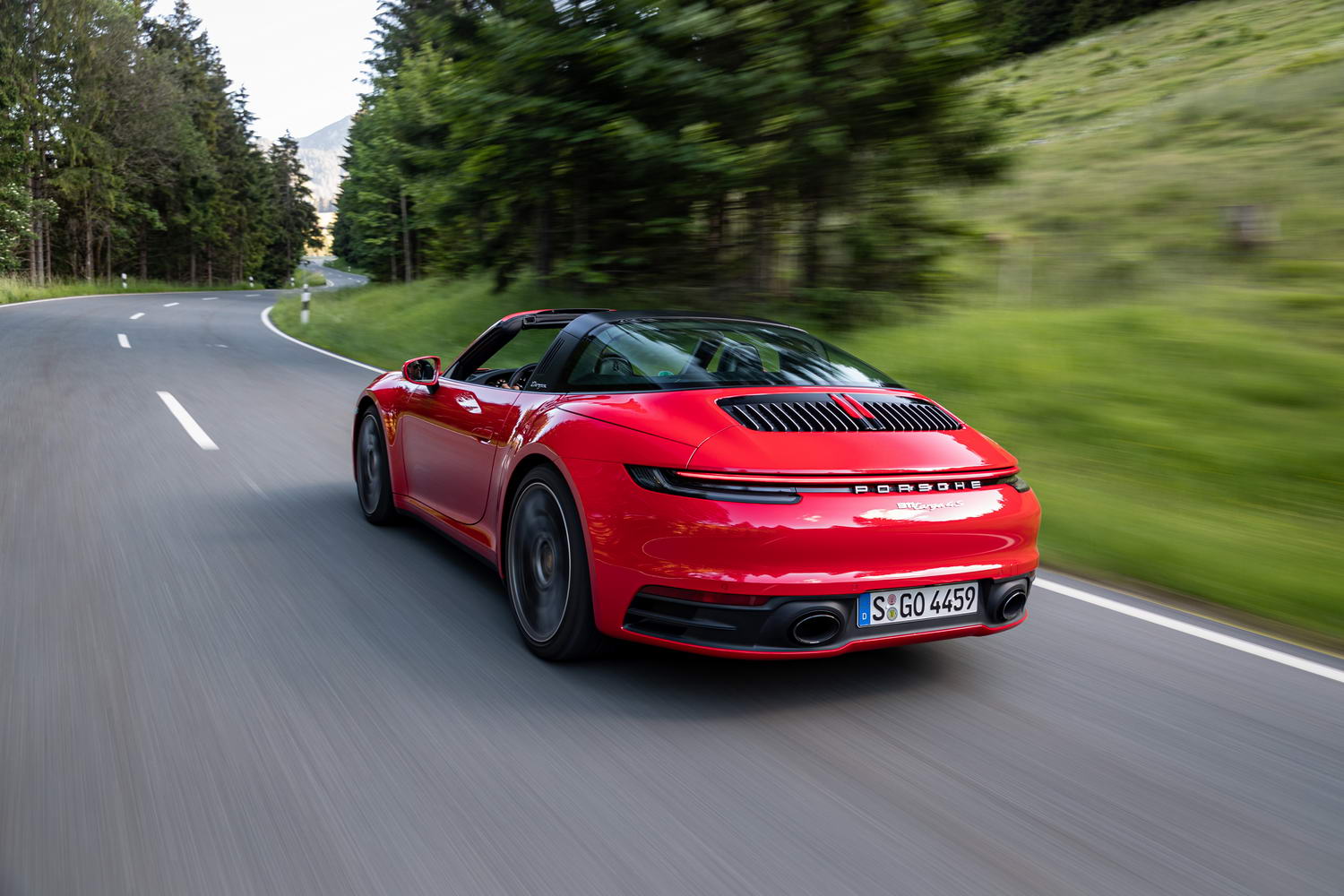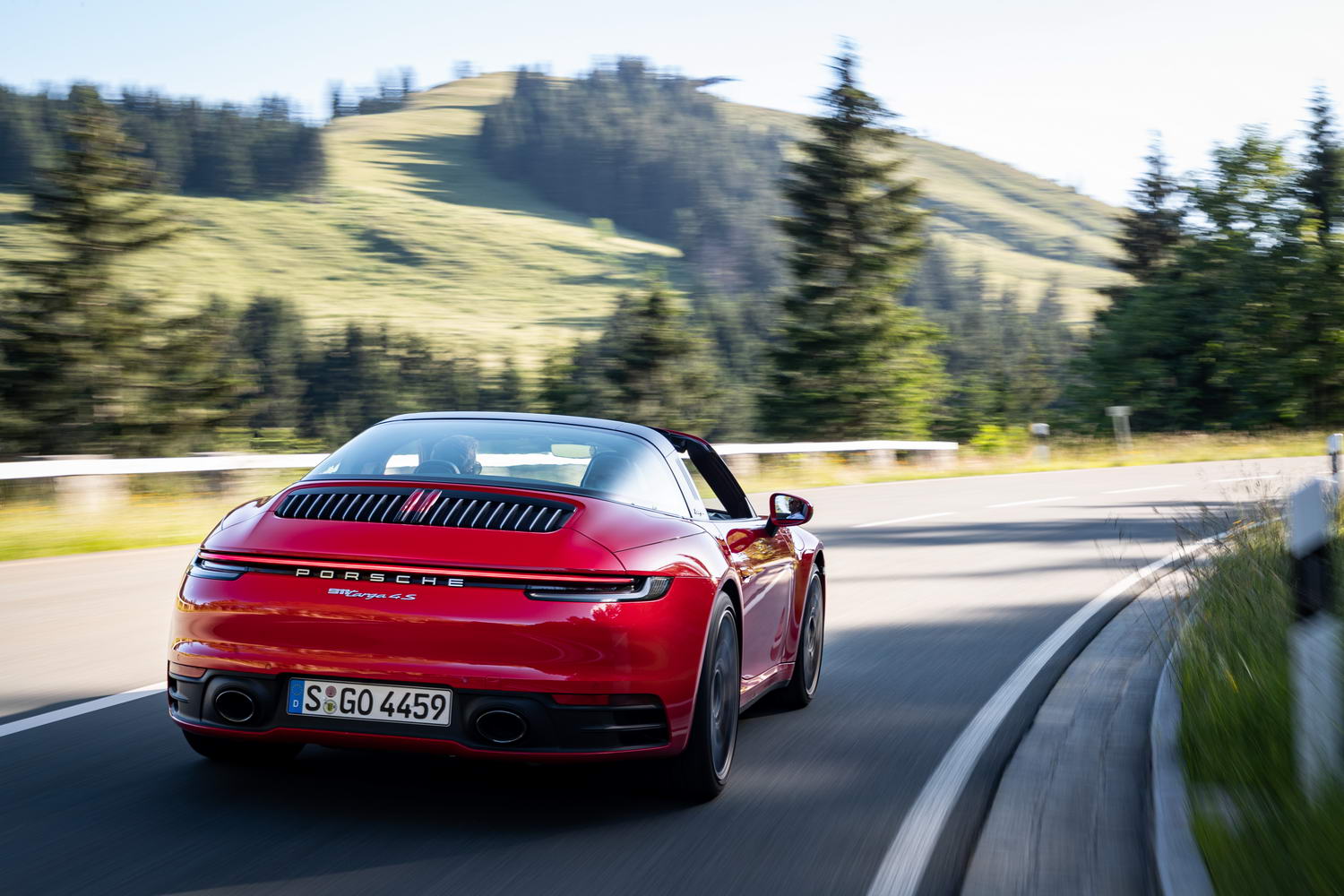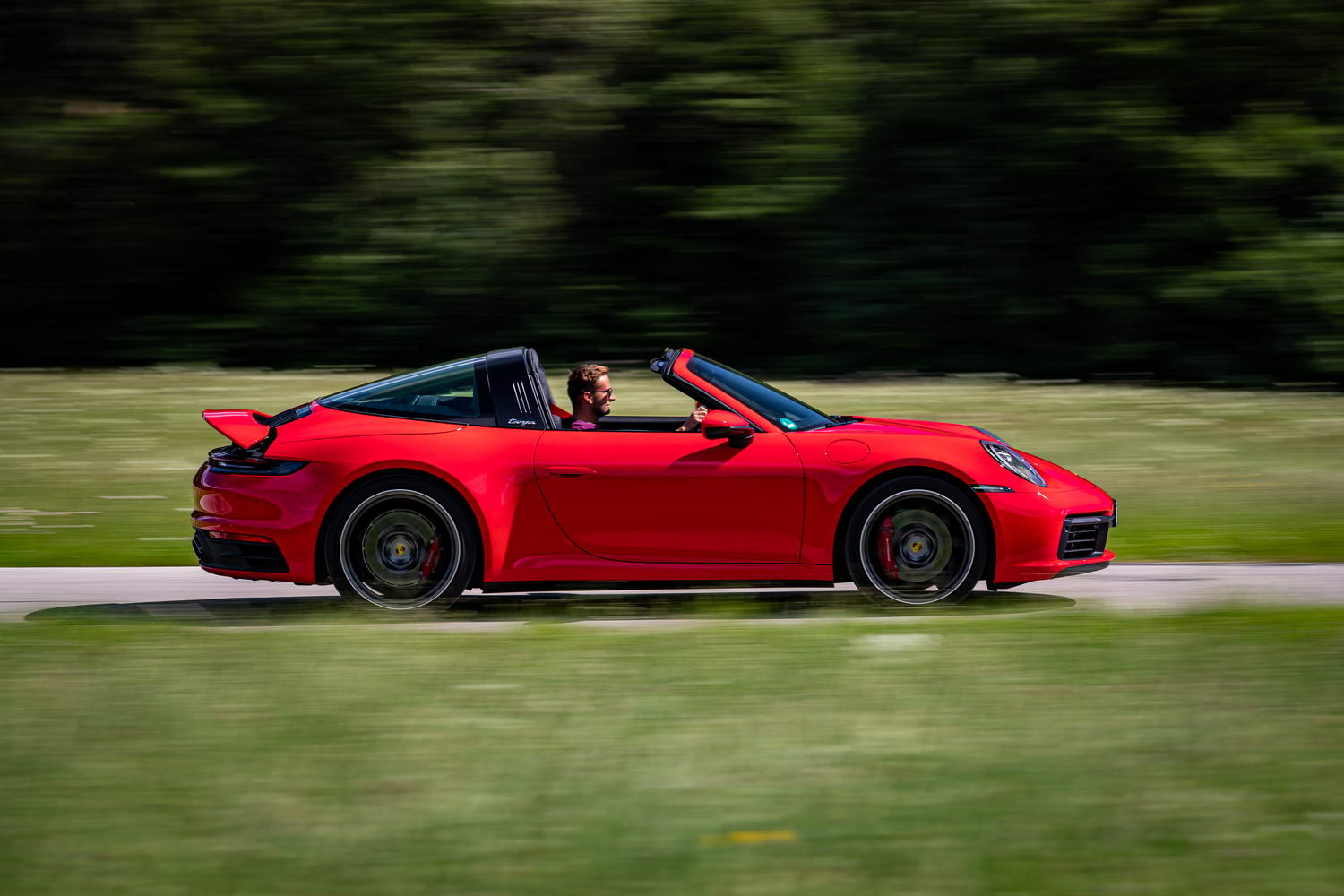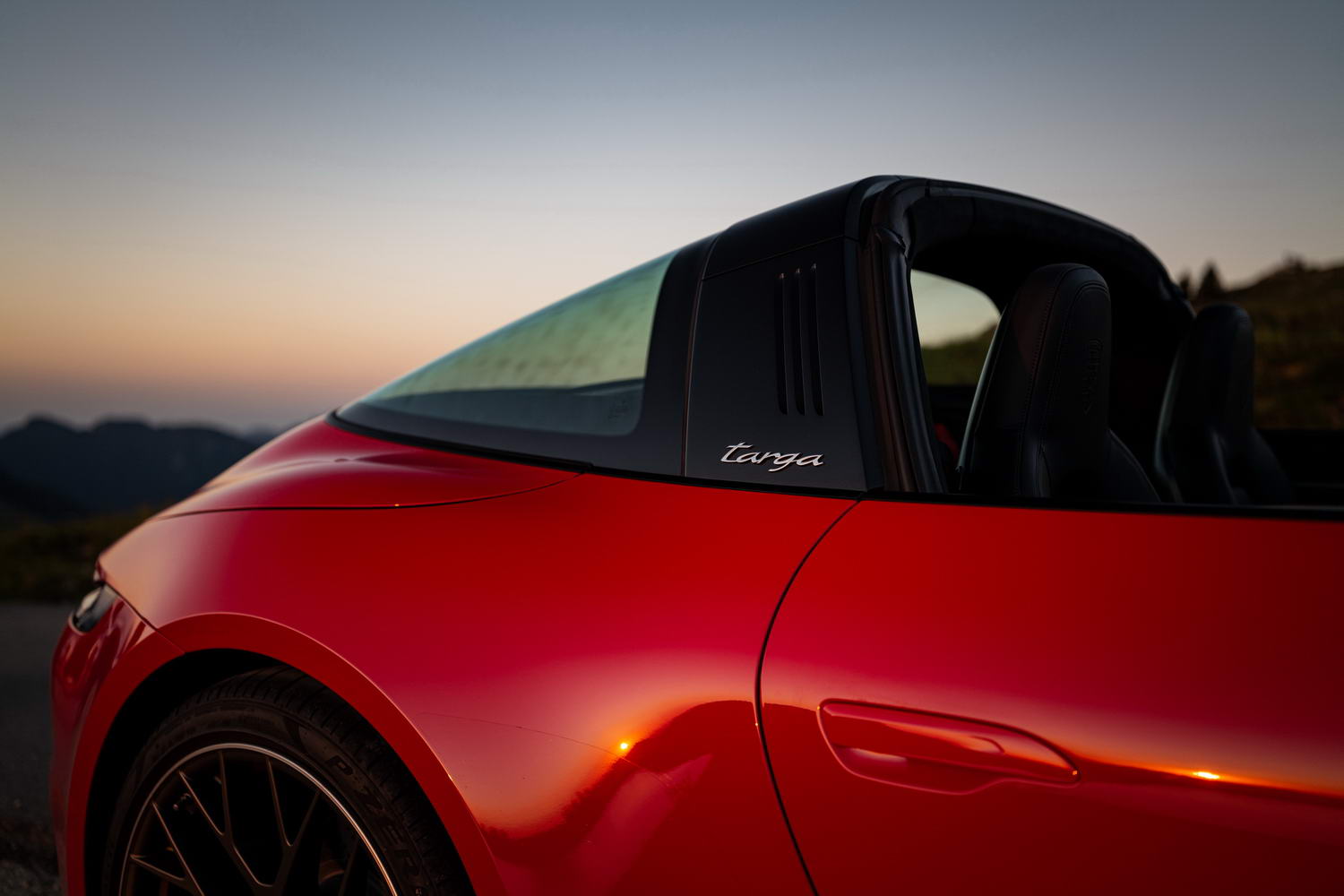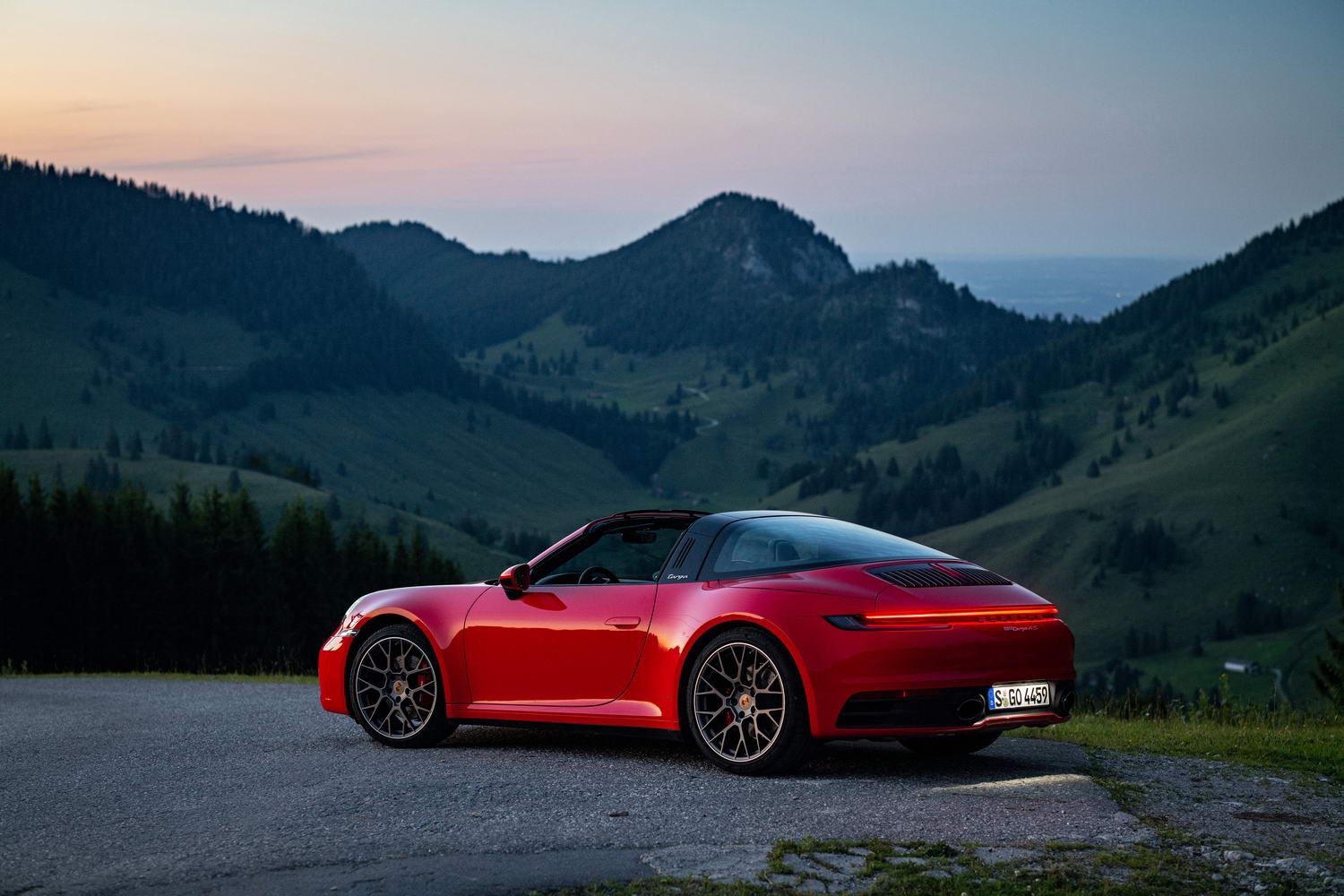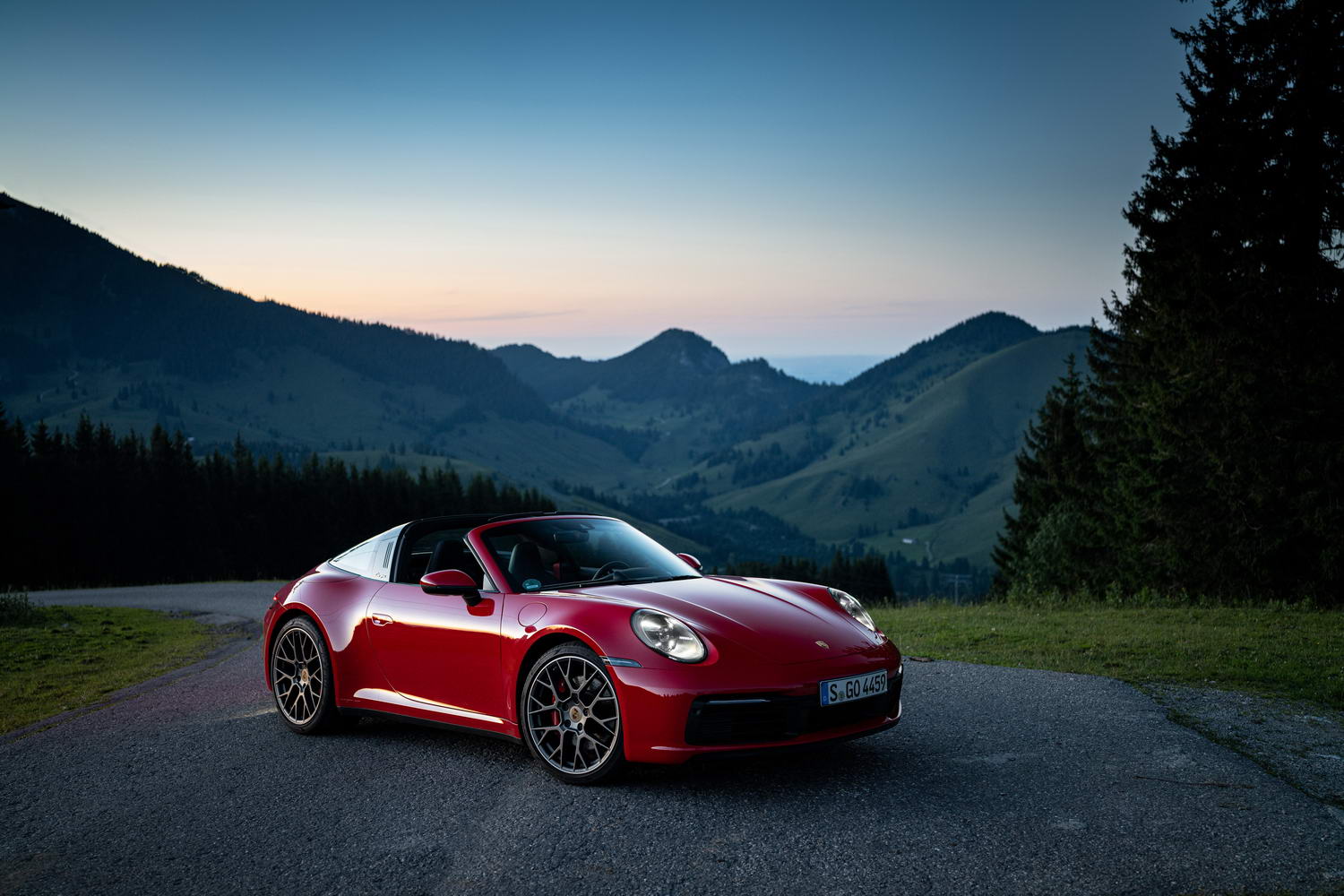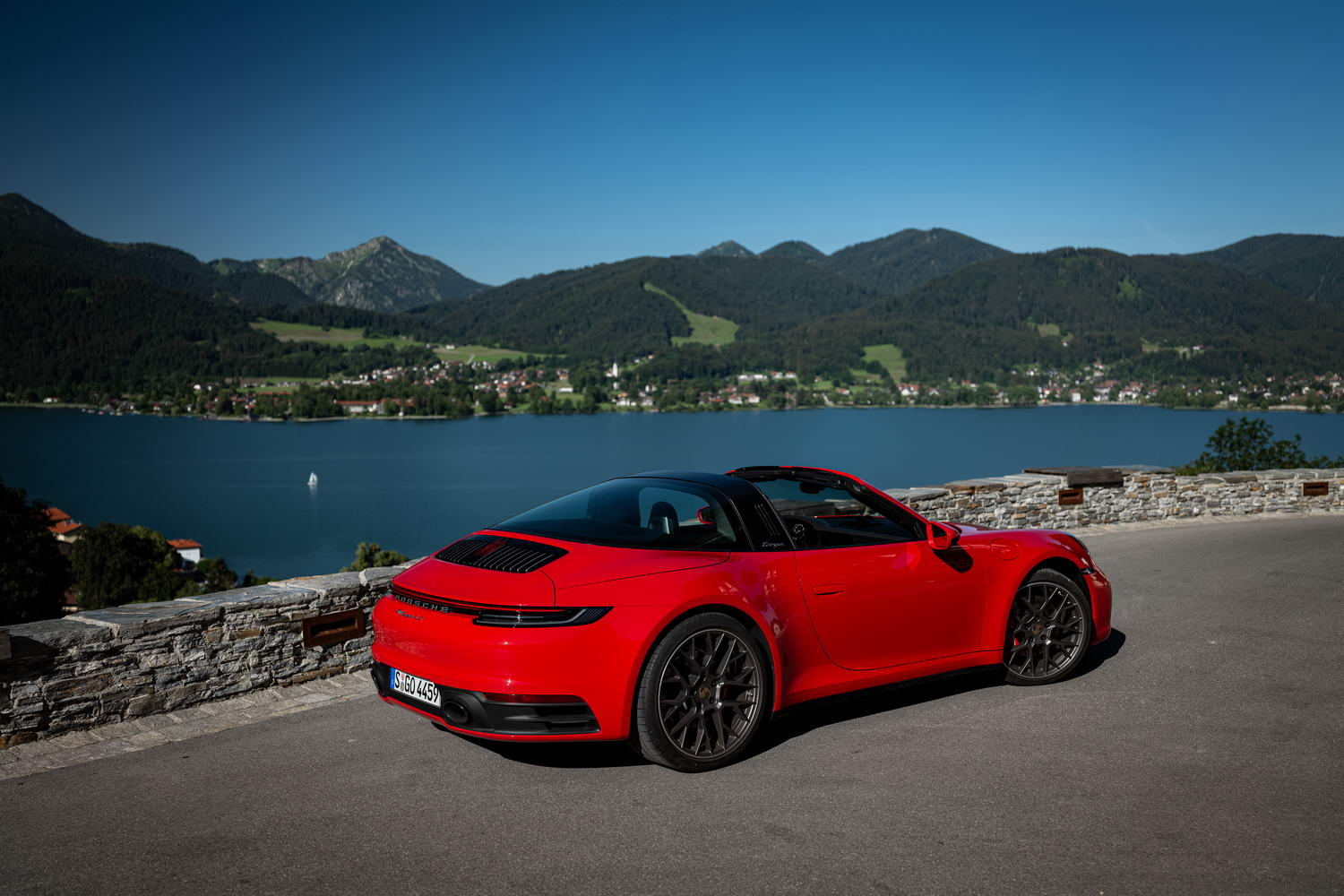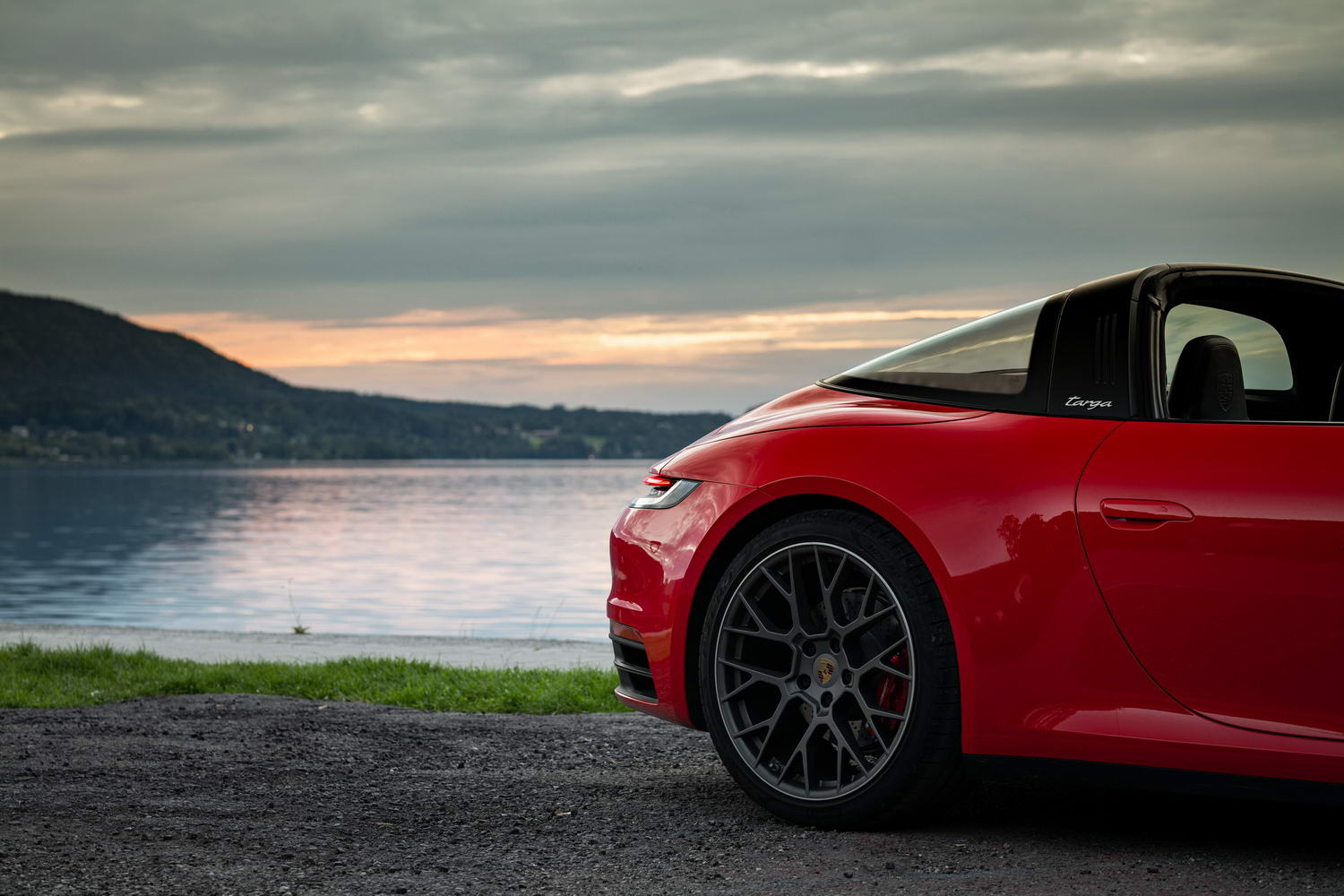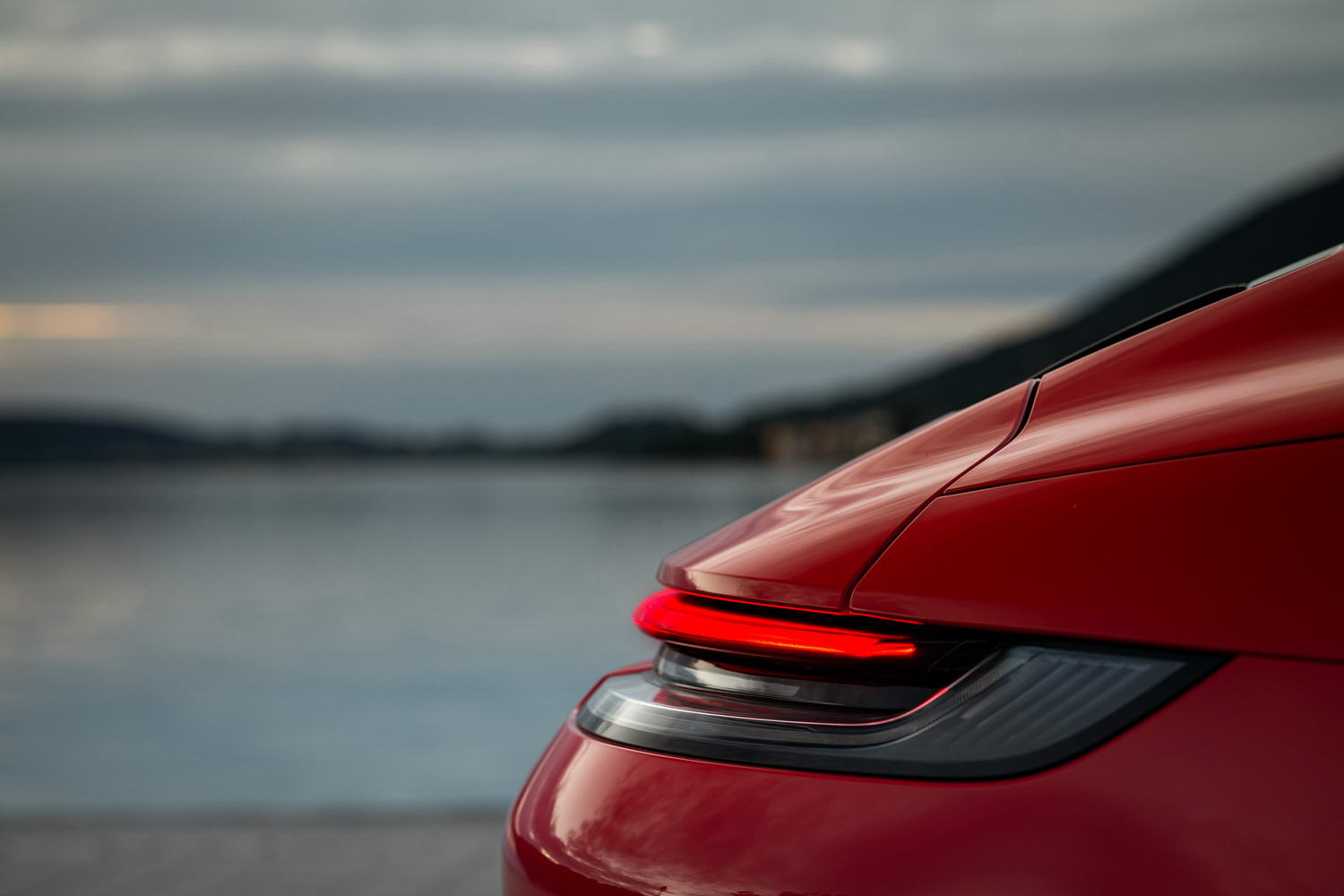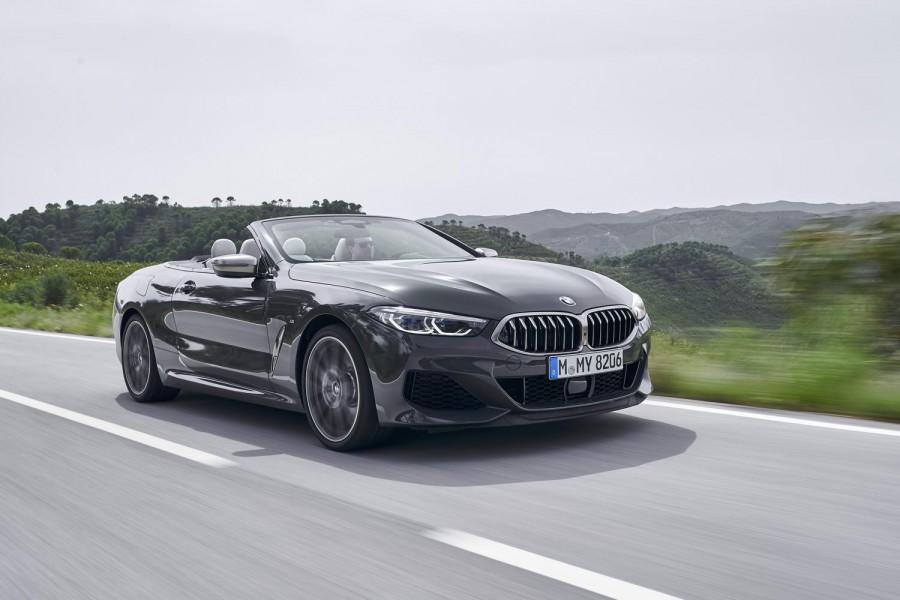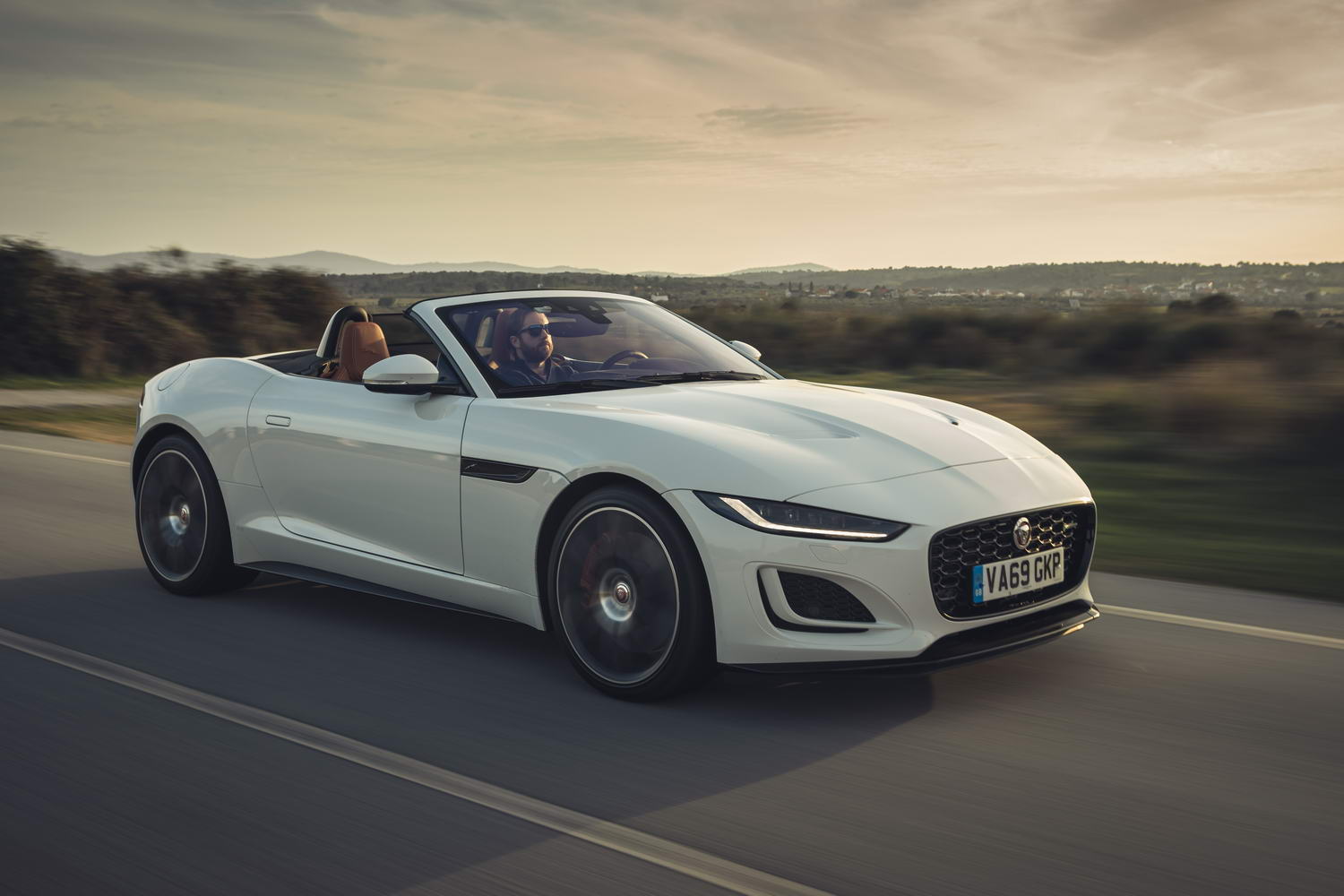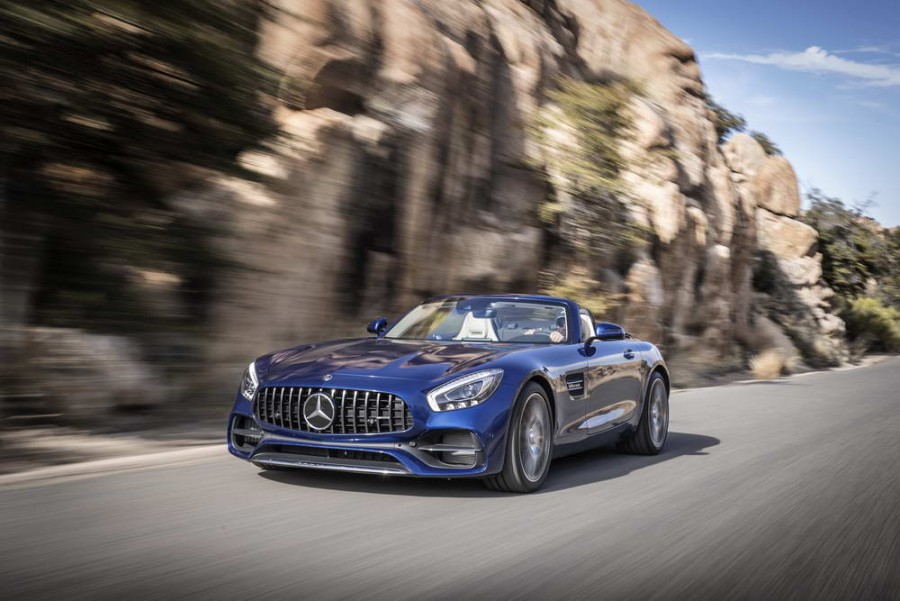Porsche quickly brings back the Targa to the 992-generation 911 family, basing much of its work on the previous 991-era convertible of the same historic name. So, do you pick this, a C4S Cabriolet or a plain ol' C4S Coupe?
In the metal
While we think the Porsche 992 Cabriolet has significantly improved dynamically when compared to its forebears, one area where it struggles a tad is with its top-down aesthetic - it can look a little clumsy from some angles, a trifle arse-heavy. No such concerns for the Targa, though, which remains one of the most glorious-looking open-tops in living memory. Its retro hoop-and-wraparound-rear-screen arrangement is carried over almost wholesale from the old 991 Targa, but teamed to the sharper looks of the 992 in general it's a thoroughly winning combination.
Inside, the Targa maintains its somewhat laughable attempts at being a four-seater (well, a 2+2, strictly speaking), although adults crammed into the bijou chairs in the rear won't thank you for being stuck there for long. Nevertheless, that second row doubles up as a useful extra storage area (163 litres of capacity, as quoted by Porsche itself) and, other than that, the Targa's cabin is as per any other 992's interior: brilliantly made, possessed of a glorious driving position and technologically right on the money. So, on pure showroom appeal, the 911 Targa hasn't dropped any points whatsoever.
Driving it
It's exceptionally good to drive, the Targa, but it's not as good as the Cabriolet and some way off the glittering handling prowess of a C4S Coupe. The reason for this is, as ever, weight. As with the preceding model, the 992 Targa is a beefy 110kg heavier than its equivalent Coupe and 40 kilos portlier than a contemporary C4S Cabriolet, thanks to extra structural bracing and a set of roof motors powerful enough to shift about an entire glass screen. Not only that, but this weight is mounted high up in the body, so you feel it on the road.
As in, while it is still blindingly quick and still sounds tremendous, this Targa 4S doesn't have quite the same alacrity of performance as other 992s with the 450hp/530Nm biturbo flat-six engine. As in, when you've got the car loaded up in a mid-speed, constant-radius bend and you open the taps as the corner exit appears, all that mass sitting up tall and far back takes weight off the front axle - so you get a smidgen of understeer that you never experience in the same situation in anything badged 'Carrera 4S', no matter what construction its roof is made of. As in, the Targa 4S feels just that little less composed and comfortable when you ask it to make reasonably high-speed, sudden flick-flack direction changes.
All subtle stuff and certainly not deal breaking, but there's enough here to suggest that, for all Porsche's undoubted chassis-engineering genius, the Stuttgart company hasn't yet managed to sharpen the Targa's handling to the nth degree. This is definitely a model of Porsche that doesn't really need any more power than 450hp, although as the highest level the 991-generation Targa ever achieved was a GTS, it's highly unlikely Porsche is about to drop the ridiculous 3.7-litre engine from the 992 Turbo S into the Targa... even though you can get Turbo and Turbo S derivatives of the Cabriolet. Says a lot, that.
However. What you therefore want to do, if you're going to appreciate the Targa to the fullest extent, is focus on the other aspects of the 992. In all its multifarious guises we've tried it so far, the current Mk8 911 manages to do a very credible impression of a grand tourer when it wants to, more so than any 911 that has gone before. And that's where the 992 Targa 4S is at its wonderful best - just driven that touch within itself, not stretched to the very limits of its dynamic talents. Indeed, such is the pleasantness of the relaxed nature of the car that you'd be far better off saving yourself a whopping €26,381 and specifying the Targa with the 385hp engine from an entry-level Carrera, rather than going 'full 4S'.
Because, when you're cruising in the Targa 4S, or rowing it along at a decent clip but not thrashing the bejesus out of the thing, it is as edifying and wonderful as any open-topped 911 we can remember, magical (and somewhat farcical) 991 Speedster aside. Porsche's little pop-up wind deflector on the header rail does a marvellous job of reducing buffeting in the Targa's cabin when the hood is stashed away, so refinement on the move is exemplary. It's even better with the roof up, where the Targa 4S manages to display 911-Coupe-like manners in terms of noise suppression and ride comfort. On that last score, this 992 has plenty of torsional rigidity so even over the very worst, lumpen road surfaces, you'll struggle to discern the windscreen's frame wobbling about the place. And the drivetrain? Well, it's a peach. Noisy and engaging when you extend it, cultured and discreet when you don't, the Targa will turn in around 9.4 litres/100km (30mpg) on a cruise and the silken eight-speed PDK transmission is as close to faultless as a twin-clutch gearbox can get. Yep, it's only if you start asking the Targa 4S to drive like a GT3 that you'll ever discern there are shortcomings to having that wonderful roof arrangement just behind your head.
What you get for your money
The Targa 4S is €12,055 less than the equivalent 450hp 911 Cabriolet and only a €5,583 price walk from the C4S Coupe, so it represents good value. It has the same kit list as its two 992 relations, too, which is actually pretty generous as standard - but which is always capable of being significantly bumped up by Porsche's notoriously lengthy options list. As we said in the driving section, we think the €159,104 Targa 4 is a more sensible proposition, given the marginal dynamic compromises the Targa's roof and weight bring to proceedings, and there's one other point to note: its quoted CO2 figure shoves the Targa 4S up into the highest motor tax band, whereas other 911 models with this engine officially scrape into Band F, saving €1,150 every single year.
Summary
More of the same from the 992-series Porsche 911 Targa, if you compare and contrast it with the 991 predecessor. That car's entire reason for being was its majestic visual appeal and referential heartstring-tugging link to Porsche's 1960s heritage. If those things appeal to you more than anything else, then the 992 Targa is clearly the default choice in the current 911 family. However, its structure does ask some compromises of the 911's chassis and so we cannot ignore the fact that, while it is a definite overall improvement on the old Targa and a fabulous open-top car in the wider scheme of things, it's not quite as talented as its preposterously gifted stablemates. Still, we're delighted the Targa continues into the 2020s - think of it as the 911 grand tourer and you'll be fine.

